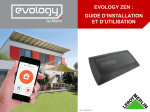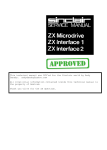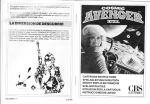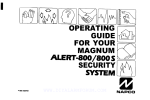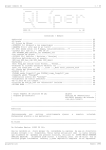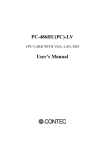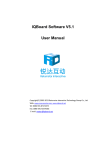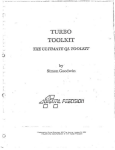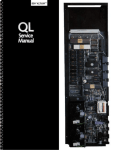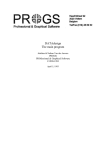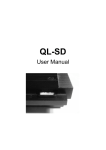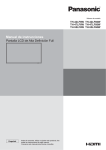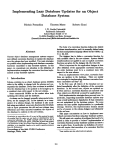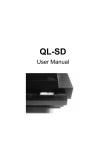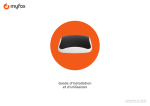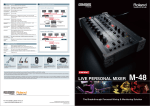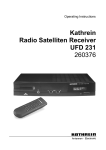Download 1 QL, QL Clones Hardware
Transcript
1 QL, QL Clones Hardware 1.1 QL Two main versions of the QL's PC board were used. The first QL's used issue 5 of the PCB, which had either ROM or EPROM versions with another ROM mounted pickaback onto IC33. The second is build standard issue 6 (volume production) which features 48k of on-board ROM which is realised in two Chips, one 32K ROM and one 16K ROM (Minerva uses one 48K ROM). The main differences are the deletion of IC17 and IC27 and the addition of IC38 HAL). It is recommended to have a QL Circuit diagram for this part of the FAQ but it is intended to be comprehensible without. 1.1.1 The Motorola MC 68008 CPU IC 18 The MC68008 is a 32-bit microprocessor with 8-bit data bus and 20-bit address bus. It is the QL's main processor and responsible for the overall timing and control of the QL. For more information get Motorolas data sheets (Family Reference: M68000 FR/AD; Programmers Referenz Manual M68000 PM/AD; User's Manual M68000 UM/AD) or read Wilf/Nausch "M 68000 Familie" pt 1&2 (I don't know if this book is available in english). 1.1.2 The Intel 8049 IPC (or 8749) IC 24 The 8049 receives the RS232 interface signals, controls the loudspeaker and joystick ports and monitors the keyboard. Instead of the 8049 some QL's have the 8749 inside which is an EPROM version of the 8049. 1.1.3 ZX8301 (Peripheral Control) IC22 The ZX8301 is responsible for TV picture generation, master clock generation, system address decode, DRAM refresh and control of the bus receiver. 1.1.4 ZX8302 (Peripheral Chip) IC 23 The ZX8302 controls all signals to and from the peripheral devices. It supervises the following signals: - Keyboard, Speaker, Joystick and RS232 (one half) by serial link to the 8049 IPC. - RS232 (other half), net, microdrive, real-time clock and interrupt control. 1.1.5 HAL/GAL 16L8 IC 38 (The following is from a brother of mine, he used a SG18 (Samsung) QL to determine it. Bad english is my fault.) title QLMOD HAL16L8 pattern QLMOD revision A author Michael Klein company Klein date 9/9/93 ;--------------------------------------------------------------------chip QLMOD GAL16V8 ; pin 1 2 3 4 5 fc1 a16 a17 /dsmc a6 6 7 8 9 10 /zx1 e8 e11 fc0 gnd ; pin 11 12 13 14 15 16 17 18 19 20 d7 dsmct /vpa int /oe o1 /pcen o2 dtack vcc ;--------------------------------------------------------------------equations int = e8 * e11 vpa = fc0 * fc1 dsmct = fc0 * fc1 ; ; ; ; ; according to QL CIRCUIT DIAGRAM (Issue 5) 1.17 IC27 2xNAND = (serial port) IC27 1xNAND = 0 at interrupt IC27 1xNAND = 1 at interrupt (behind vpa = AND with fc0, fc1 ; ZX8302 is (in german (SG18 - Korea made)) connected directly ; with the 68008 databus : ; The oe signal for the 74LS245 may not be active then. ;---------------------------------------------------------------------oe = zx1 * /pcen * dsmc ; New Chip Select for the ZX8302 ;---------------------------------------------------------------------pcen = a16 * /a17 * /a6 * dsmc ; o1 = pcen * /fc0 + pcen * /fc1 ; not necessary , test ; DTACK from new Chip Select. ; Also generated by the ZX8301, because it generated the pcen in ; times when the ZX8302 was connected to the CPU through the ; 74LS245. ; Now that's the job of the GAL. ;---------------------------------------------------------------------dtack.trst = pcen dtack = gnd ; END QLMOD GAL16V8 1.1.6 Microdrives The microdrives are used as 'mass storage device' in the Sinclair QL. As media you have little 'cartridges', which tend to be unusable after a more or minder long period of time. Only one microdrive may be used at any time. The selection of the drive and operation type (read or write) is done under software control. You can write protect any cartridge by removing the write protect tab on the micro drive cartridge. When the tab is removed a microswitch is released which disconnects the write heads power supply line. Sometimes it's possible to format a cartridge though it is writeprotected. The problem is caused by several things which are supposed to tell you whether the spinning MDV is write-protected (SV_WP, which is extracted from the IPC 'info' command) tend to lie. [Oh, and surely most MDVs could be described as 'badly made units'? <Richard J. Kettlewell>]. 1.1.7 Power supply (I think I should write something about it, but I don't know what.) 1.1.8 Build Standards, Differences Build | IC | ROM / EPROM | Software | Remarks Stand. | | ROM EPROM | Standard | -----------------------------------------------------------D6 | 33 | --32K | AH | 16K of EPROM mounted | 34 | --16K | | pickaback on IC33 -----------------------------------------------------------D7 | 33 | --32K | JM | 16K of EPROM mounted | 34 | --16K | | pickaback in IC33 -----------------------------------------------------------D8 | 33 | 32K --- | AH | --| 34 | --16K | | -----------------------------------------------------------D9 | 33 | 32K --- | AH | --| 34 | 16K --- | | -----------------------------------------------------------D10 | 33 | --32K | JM | --| 34 | --16K | | -----------------------------------------------------------D11- | 33 | 32K --- | JM | --D14 | 34 | 16K --- | | -----------------------------------------------------------If you have build standard D8 or below or D10 an upgrade to D11 or later firmware is highly recommended. Build Standards D16 and higher incorporate some modifications to improve microdrive performance. The last standard of britain made QL's was (at least) D17 (SQLW Apr. 87, p. 13). Samsung QL's were of standard SG18 (I don't know of more). The various QL PCB's also had issue numbers which corresponded to blocks of the D numbers: Issue <= 4: pre-production Issue 5 : D06 - D13 Issue 6 : D14 - D15 Issue 7 : D16 - D17. 1.2 Sandy Q-XT 640 The Sandy Q-XT 640 had a Original QL main board with 128K RAM; a Super QBoard with 512K RAM, Centronics printer port, Super toolkit II, Floppy disk controller; 1 or two 3.5" drives (1MB); a Full travel keyboard IBM-AT style; a new internal 60W switching power supply and 3 expansion slots. 1.3 CST Thor PC (later Thor 1) The Thor PC had 640K RAM; 128 user EPROM space; a JS based 'extended' operating system; battery backed clock; IBM style 84 key keyboard; centronics and serial ports; mouse port; ICE + front end; full user port at rear. 3.5" floppy disk storage; network capability; optional 20MB harddisk. The Thor PC had a new PCB. Each Thor computer came with the PSION XCHANGE package (version 3) which was an enhanced version of the PSION QL packages. You can run up to six tasks simultaneously, automatically switching data between programs. XCHANGE has the TSL task sequencing language to automatically control each task via a simple program. Included with the Thor was an improved version of the ICE computer front end. The Thor PC came in three variants: a) Thor PC 1F with single 720K 3.5" disk drive b) Thor PC 2F with double 720K 3.5" disk drive c) Thor PC 2FW with 20MB Winchester + one 720K 3.5" drive. 1.4 Sandy 68000 PC (Futura, formerly QLT; never apperared) The Futura had following technical details: a) Hardware. MC68000 8MHz CPU; 128K exchangeable system ROM; 512K to 8MB RAM; two externam ROMPer connectors; two internal ROMPer connectors (ROMPer/RAM bus); complete bus connector; QL compatible display controller; two full duplex, independent baud rate serial ports; MIDI output port; QL compatible network through port; parallel port; mouse port; sound generator; up to three 3.5" floppy disk drives or one 3.5" hard disk drive and up to two floppy disk drives; battery backed real time clock; internal PSU; 89 key IBM AT style keyboard with CAPSLOCK LED and joystick port. The Futura also had 16-bit video, ie 65536 colours at a time. (source : QLSUB#0) b) Software. QDOS compatible operating system with extended window handling, pull down and static menu handling, integrated pointer environment and improved error reporting; a SuperBASIC compatible programming language with faster execution and all Supertoolkit facilities; a hotkey/mouse driven interface with file manager, spooler and job manager. (Tony Tebby design) (This seems to be the beginning of all this SMS2/Ora things now) 1.5 CST Thor 20, 21 (This parts consists of excerpts from articles and advertisements in SQLW in 1988.) The Thor 20 system is based on the Motorola MC 68020 32 bit processor with optional MC 68881 Floating Point Coprocessor and a choice of two clock speeds (12.5 (12.0?) and 16.7 MHz). The Thor 20 was supplied with Motorola's User Manuals for the MC 68020 and MC 68881. Also provided was a suite of development software comprising an extended Macro Assembler by Talent Computer Systems which supports the full MC 68020 and MC 68881 instruction sets, and a Linker by GST. Plus (of course) the software which already the Thor PC came with. The Thor 21 was the Thor 20 with the FPC option. Both came in the same three variants as the Thor PC. 1.6 CST Thor XVI The main processor board of the THOR XVI contains a 68000 processor running at 8 Mhz. The onboard half Megabyte of memory is multiplexed between the processor and the video control circuitry, which generates a superset of the QL video modes. The expansion memory slots allow up to 6 Magabytes to be added concurrently (with the new 4Mbit devices this will be increased further). All input and output functions are carried out by a 2 Mhz 6802 on the I/O processor board, which is designed to be standard across the range of THOR machines. Video pixel rate is 10.67 MHz, which allows 512 pixel per line display on a standard monitor without overscan. The video modes now include a 16 colour facility for colour monitors which have an intensity input, or a 16, level grey scale in monochrome. The advertised "superset of QL video modes" was in fact the two normal QL modes (512x256x4 and 256x256x8) with one extra "MODE 12" giving 256x256 pixels in 16 colours. The promised highermemory expansion cards never went into production and so the maximum memory which may be fitted to a Thor XVI is 6.5Mb. The QL compatible expansion slot allows the use of existing add on cards (except memory). The input/output board has two type of function: interfacing with disc storage devices and the real time clock, and providing communications to the outside world via the mouse, serial, parallel, keyboard and network ports. Floppy disc and optional SCSI interfaces are controlled directly by the main processor as the peak data transfer rate is high but intermittant and so causes only a low CPU overhead. Also directly accessed by the main processor is the battery backed real time clock (there is no CPU overhead in accessing this) and the "User" eprom slots which are 8 bit wide for ease of programming. All other I/O functions are handled by the 2MHz 68B02 microprocessor: this receives commands and data via the dual ported ram, shared with the main processor, which only sees "perfect" devices, Qdos compatible queues and buffers. It is the intelligence of the 68B02 that releases the main processor to get on with its own work. It also provides greater functionality: e.g. as well as "BEEP" interface to the loadspeaker's driver, there is a queue allowing digitised sounds to be generated and then simply sent to the I/O Board. The "outside world" interfaces are seen from right to left at the front: the video output, the network ports (an enhanced version of QNET), serial ports which support the proposed BS-5/8 (DIN connector) standard, split baud rates, x-on/x-off protocols etc, AT compatible keyboard connector, parallel port (BBC micro style) and a fully useraccessible mouse port. While fully compatible with Qdos and the QL, the Thor XVI has enhanced networking, single key multitasking, up to 6.5 Mb of dynamic ram and all delivered at the very least at twice the speed of the QL. For the professional user there are now 20MB and 40MB hard discs complemented by a choice of either single or dual 3.5" floppy disc drives. For overseas Thor XVI users (and for not a few foreign language students in the UK), the keyboard layout may be selected dynamically along with national error messages ans character sets for more esoteric languages such as Greek and Russian. The Thor XVI Range Thor XVI CF (Workstation) Thor XVI IF (Single Floppy) Thor XVI FF (Dual Floppy) Thor XVI W20F (20MB Winchester, 1 Floppy) Thor XVI W20FF (20MB Winchester, 2 Floppies) Thor XVI W40F (40MB Winchester, 1 Floppy) Thor XVI W40FF (40MB Winchester, 2 Floppies) A pleasant revelation and against all reasonable expectation the Thor User Guide proved not to be a direct copy of the often maligned QL manual. With a few minor exceptions the manual is presented in a clear and concise manner. The user guide is a single document comprising four manuals and five parts relating with the XChange program suite and deals with various aspects of using the Thor and its accompanying software. Manual 1 describes the Thor hardware and connections to the system. Manual 2 provides detailed axplanations of SuperBasic and its syntax. Manual 3 is a glossary of SuperBasic keywords and provides evidence that much of Tony Tebby's Toolkit II has been incorporated into Thor SuperBasic. From Manual 4 onwards users are given detailed instructions concerning the use of XChange and the parts following it deal with each of the components of the XChange system. Parts 2, 3, 4 and 5 are for Quill, Abacus, Easel and Archive respectively. Part 6 is devoted to the appendix which is divided into three sub-sections, covering finer details such as Import and Export of files and matters relating to printers. Copious explanations and examples concerning language syntax have been provided in manual 2, initiating a user new to SuperBasic and the finer points of programming. Looking through the section devoted to keywords it soon becomes obvious that SuperBasic on the Thor includes a fully-implemented version of the skeletal framework of error-trapping added to the QL JS ROM. In common with the QL User Guide before it, an index of the contents has not been provided, leaving the user to search for specific information in relevant sections. In common with the QL, the Thor package includes the now industry-standard Psion quartet of business software XChange and is supplied as a single program package with an integtral dedicated multi-tasking controller. Users may elect to switch between any number of versions of Psion Quill, Archive, Abacus and an enhanced Easel with an option for a 3D graph display, within the limitations of available memory. Individual copies of the programs are assigned user-defigned task names. The serial ports on the Thor XVI are completely under the control of the I/O Board's MC68B02 processor, relieving the MC68000 Main Processor of the handling overhead. The ports are implemented using the MC68682 DUART (Dual Asynchronous Receiver Transmitter for acronym buffs) allowing multiple baud rates between channels. For example, port 1 could "talk" to a Prestel type modem running at 75 baud for transmission and 1200 baud for reception by opening a channel called "Set 11/7561200". With port 2 simultaneously driving a standard serial printer at 9600 baud (the default) with a 10 kilobyte buffer as "ser-10k". The baud rates can be selected from: 75, 110, 134.5, 150, 300, 600, 1200, 1800, 2000, 2400, 4800, 9600 and 19200; CST claim that this should cope with almost all possible configurations! Other options available are the setting of parity (odd, even, mark, space or none), bits per byte (5, 6, 7 or 8) and translation protocol (various interpretations of newline are supported as is "TRA" for international users). A new facility is the built in support of the x-on/x-off software protocol (as used by DEC, Unix etc) which allows simple three-wire cabling to be used. Physical connectors and voltage levels are as defined by draft British Standard BS-5/8, which uses audio-style 8-pin DIN connectors for convenience; most aplications will only need five of the pins (the remainder providing auxiliary handshake and 5 volt power) and can be connected by "sterio" reversing audio leads; if x-on/x-off is used, as "mono" cable may be used. The voltage levels are CMOS; these can normally be interfaced with the older RS-232 by means of a simple resistor. The Thor XVI network is upward compatible with the standard Thor's and the QL's. It is again driven by the I/O Board's processor, significantly reducing the main processor overhead; this is particularly important with machines acting as file server, as no network overhead occurs on the new system unless data is actually being transferred. 1.7 Futura Data Centre QL emulator board for the Atari ST This emulator board was also called Strong QL/Atari emulator. It was developed originally by the Norwegian firm Futura Data Centre - no relation to the QL derivative - for its own communications system and has since been refined for commercial release. The complete emulator kit consists of the hardware adaptor, an Atari-formatted disc containing the relevant files for switching the ST into QL mode and a QL-formatted disc containing a routine which will extract the QL ROM and transfer QDOS from your QL to a previously Atari-formatted disc. The emulator hardware consists of a small printed circuit board on which is mounted the displaced Atari Shifter chip, a QL 8301 ULA and several surface-mounted TTL chips. Installation of the emulator card requires that all of the Atari internal metal shielding be removed. Connection to the ST is made with only seven wires but two connections to the Atari GLUE chip must be modified to allow software to switch the Atari into QL mode. (source: SQLW, Oct. 1988, p.20) 1.8 Miracle Systems Gold Card The Gold Card has a 16 MHz 68000 prozessor, Supertoolkit 2 and a floppy disk controller with Level II device drivers. You can connect up to three disc drives with DD, HD and ED drives in any mix to the Gold Card. The Card has 2MB of dynamic RAM in four SIM chips. At startup the card copies the original ROM into its RAM. The 68008 is disabled, but the ZX83 custom chips and the 8049 IPC work normally. It is possible to connect a hard disk, but no other extension. The same software as in the Trump Card is included. The Gold Card's current version is 2.32. 1.9 ICL One Per Desk (also Merlin Tonto or Computerphone) (This FAQ part is an (shorted) article in SQLW in Oct. 1991) The OPD (One Per Desk) computer was made by ICL Ltd., as a collaborative project between ICL, British Telecom and Sinclair with Psion providing the software. The same machine was badged for BT as the Merlin Tonto and for Australian Telecom as the Computerphone. The machine was intended for the busy executive with only limited computer skills. Most operations use multiple choice menus. The hardware is based on the QL using the same 68008 microprocessor, QL ULAs, 128K of RAM and microdrive data storage. The machine has a 'footprint' of about the same length but twice the depth of the QL. Being launched shortly after the QL, the OPD suffered from the bad publicity attached to the microdrives, although ICL had much improved the reliability of the units. Despite this poor start, many hundreds were sold to local authorities, government departments and large companies. A typical OPD featured a mono (black and white) monitor, twin microdrives, battery-backed clock, on-screen calculator, enhanced telephone handling, modem, XChange software (Abacus, Archive, Quill and Easel), Basic and messaging (fax look-alike between OPDs). The OPD is designed to be left on and the screen will blank if no keys are pressed for 10 minutes. Pressing any key, or an incoming call, re-activates the screen. The monitor is intended to be switched off between sessions leaving the computer powered for unattended functions. Monitors are available in 9 inch black and white or 14 inch Microvitec colour. The microdrives are similar to those on the QL, bat save the data in a different density. Although blank cartridges can be used on either machine, the OPD cannot read QL cartridge data. There is a program (for the QL) by Dave Walker of DiscOver fame, that can convert data and Basic from the OPD to the QL and vice versa. The OPD records cartridge use and read failures, and warns when the cartridge is due to renewal. The microdrives are very reliable. The telephone has auto-dialing from a saved Telephone Directory / Adress file of as many as 500 entries if required, with optional monitoring of cost and duration of calls. A running total is kept in memory. The directory has a search routine and short code dialling. There is a re-dial facility of any of the last six calls. Calls can be initiated through a built-in loudspeaker, the handset being picked up only when the connection is made. The machine will answer incoming calls using a programmable computer voice chip with different replies available for different times, eg lunch, holidays, gone home etc. There is no facility to record incoming calls. The modem is built-in and capable of Viewdata and Glass Teletype communications. This enables connection to Prestel, Yellow Pages, Tony Firshman's Board and many others. Screens can be saved to memory using the 'Snapshot' option, or entire programs can be downloaded to microdrive. Text can be prepared off-line to save phone charges. The software is an enhanced suite of the programs supplied with the QL with the import/export of data between applications simplified. Being ROM-based, it loads quickly and without read failures. The four are brought together under an operating 'shell' called Xchange Task Control. Up to eight 'tasks' can be in progress at one time. Import and Export between Psion programs is fast and simple. Xchange was an optional extra. Basic is loaded from certridge and is a reduced version of Superbasic. Many of the features of Superbasic are not available on the OPD. There are no graphics as such (CIRCLE, LINE, BORDER, FLASH etc.), no EXEC and no DIR. The screen size is also slightly smaller. QL Superbasic programs can be transferred to the OPD but need considerable editing before use. Although using the same CPU, QL machine code programs cannot be run on the OPD. There are differences in the way the OPD handles the screen etc. that make QL programs incompatible. Many OPDs were supplied with 'Messaging', a fax look-alike. This is in the form of a capsule that plugs into the back of the unit. The capsule contains a ROM eith the necessary code, which enables OPDs to send pre-types text to each other using the telephone system. Received Messages can be edited and sent on to other users, printed or saved on microdrive. Later ROMs allow the messages to be sent at pre-set times and to different numbers to take advantage of cheap rate calls. The OPD is provided with a serial port, but works in one direction only, being intended solely for printer use. It is possible to download Basic files directly to the QL using the SER2 port on the QL and a suitable cable. No input from the QL is posssible by this route. Later improvements included disk drives from PCML (with 256K extra memory), and another from Computer One, but these are no longer manufactured and can only be obtained on the second hand market. A variety of plug-in capsules were also provided, but most were to enable the OPD to ICL mainframe computers and are of little use to enthusiasts. There were later options to allow direct transfer of files direct from microdrive, via the telephone line, between OPDs and to import data into Quill or Abacus from Bulletin Boards. It is not possible to simply plug-in extra memory as on the QL because the OPD requires special code to 'log-on and identify' the memory. A 128K expansion unit was made but few seem to have been sold. Software is in very short supply, possibly because there is no organized usr group such as Quanta, although some business oriented programs were produced. A diary/ appointments program has been seen and also a CP/M operating system is available on one version of the disk drives. It is reported that Basic and 'C' compilers were produced but no sign of one has been seen. QL owners who use their machine mostly for the Psion package will find the OPD easy to use and in a business environment, a very useful tool. Sadly, it suffers from the lack of compatibility with the QL in the most important area, programs. Very little software is produced for the QL in Superbasic now and useful programs and Tony Tebby's utilities cannot be used. The most promising area lies in Xchange applications and it is possible to transfer the Archiver group of programs once sold by Eidersoft. 1.10 Merz QVME Card The QVME Card is a VME-based plug-in card for the Atari Ste and TT series which contains a QL emulator. This card emulates standard QL, the screen resolution is programmable (at runtime) e.g. 1024x830 or 1280x700. The card has simply to be plugged into the STe's (TT's) VME bus. For use with the standard ST you need an extra adapter. The caard has a monitor connector to be connected directly to a multisync monitor. The QVME card can't use monochrome monitors. It has a 'compatibility mode' for use with programs which write directly into the QL's screen (i.e. the RAM area which represents the screen output). You can use up to 4MB of the Ataris RAM for QDOS. Furthermore all of the Atari's devices could be used for QDOS, e.g. disk drives, serial ports, the parallel and the mouseport, harddisks. By reason of the different hardware there is no QL network available on the Atari. The Device drivers are offering additional options, e.g. real subdirectories on harddisk, named pipes etc. The emulation software is on a disk and has to be loaded into the Atari (that means, you can use the Atari as Atari as well.). 1.11 Miracle Systems QXL Card (This part is a copy of Miracles advertisement in SQLW plus some additional information.) The QXL turns the common PC into a QL compatible. The package comprises a half card that plugs into an 8 or 16 bit standard ISA slot and a diskette loaded with a QDOS compatible operating system and a Superbasic compatible interpreter. After installation simply type QXL and the PC will appear to be a QL allowing QL programs to be run from QL format diskettes. The card itself has a 32 bit 68EC040 processor running at 20 MHz which gives a good turn of speed. This processor has access to its own RAM and so performance is virtually independent of the host system whether it has an 8088 or a Pentium. In fact the PC is used purely as an I/O system giving QL programs access to the PC's floppy disc, hard disc, keyboard, display, serial and parallel ports. The card itself has QL style network ports to allow connection to a QL network. The minimum PC specification required is an XT with EGA display and a spare standard slot. RAM sizes of 4M and 8M can be supplied. Smaller capacities (1M and 2M) will not be longer sold. The smaller capacity can be upgraded to the larger one and the cost is simply the price difference. Not all the RAM is available to the user programs; The 1M version equates roughly with a Trump Card QL, the 2M version with a Gold Card QL and the 4M QL eith a SuperGold Card QL. Miracle intends to provide software upgrades free of charge. Supported screen resolutions are 512x256 (with a huge black border), 640x350, 640x480, 800x600 ( i.e. QL screen, EGA, VGA, 800x600SVGA); half those in mode 8. The 'FLASH' attribute is not supported. There's no support for more than 4 (8) colours, not for changing the appearance of the 4 (8) that you get. The 'hard disk' as seen by the QXL is in fact a large file C:\QXL.WIN which contains a filing system which is (presumbly) similar to that found on other QDOS hard disks. You're not restricted to the C: drive, you can have win2_ on D:, win3_ on E:, etc. It still works if you create a QXL hard disk on a double-spaced MSDOS drive. You can't format a disk from the QXL directly. As Tony Tebby pointed out in IQLR DOS has a somewhat awk formatting routine (about 32K, as big as QDOS), so you must 'preformat' your disk on MSDOS and then 'crossformat' it from the SMSQ prompt with the standard 'FORMAT flp1_' command. Currently (v2.50) you can use four different keyboards and/or languages: american, french, english, german. The manual explains the additional and altered commands. This manual is in fact a Toolkit II manual with supplements for GC, SGC and QXL. 1.12 Miracle Systems Super Gold Card (This part is a copy of Miracles information paper about the SGC) The Miracle Systems Super Gold Card has the following features: - 24 MHz 68020 processor -> 3x speed of GOLD CARD - 4M bytes of 32 bit wide RAM - CENTRONICS parallel port - Built in improved Disk Adapter for DD/HD/ED - Virtuallly crash proof battery backed clock - External 5V socket for optional 5V supply This is the first major revision of Miracles highly successful QL GOLD CARD. Its most signeficant attribute is the speed of the 68020 processor running at 24 MHz yielding a threefold speed-up over the GOLD CARD - so you can now get QXL speed from your QL. The RAM is increased to 4M bytes and a CENTRONICS port has been added which is especially good for sending graphics information to printers efficiently. The disk interface has 2 connectors so that 2 double disk drives (4 mechanisms FLP1_, FLP2_, FLP3_, FLP4_) can be connected without the need for a DISK ADAPTER. The drives can of course be DD (double density, 720K), HD (high density, 1.44M) or ED (extra high density, 3.2M) in any mix. Another minor improvement is the protection of the clock time against crashes. A special sequence of accesses is now required to alter the clock so it is not affected by 'stack crawl', etc.. And if you run your QL system off a switch mode power supply you do not need to hack the regulator; just plug the 5V straight into the SUPER GOLD CARD. WARNING: You'll have to power the SGC and the QL PCB from the same power supply or you are likely to get into trouble!









